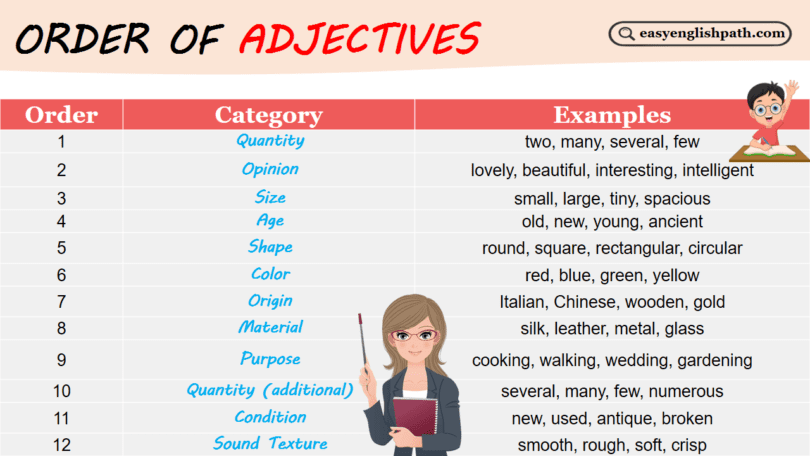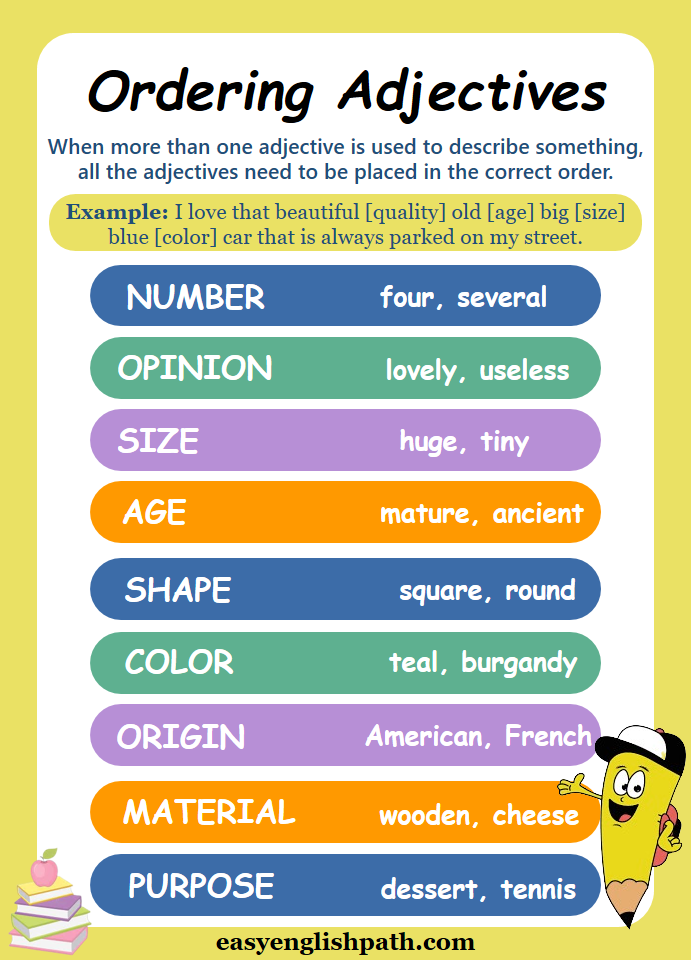In English, when we use more than one adjective to describe a noun, they must follow a natural order. This order helps sentences sound smooth and correct. Adjectives usually follow this sequence: opinion, size, age, shape, color, origin, material, and purpose.
For example, we say a beautiful big old wooden table instead of a wooden old big beautiful table. Learning this order makes your English sound more natural and clear!
What is Adjective Order?
The Order of Adjectives is the way we arrange different words that are used to describe a noun. When we use more than one adjective to describe a noun, there is a specific order we usually follow.
Rules of Adjective Order
- Quantity or number
- Quality or opinion
- Size
- Age
- Shape
- Color
- Proper adjective
- Purpose or qualifier
1. Quantity or Number
Quantity or number is referred to the first element in the order of adjectives when you want to describe a noun. It used to indicate how many or how much of the noun there is. The following words are used to tell a specific number or quantity, such as two, many, few, some, or several.
- There are several books on the table.
- He ate two slices of pizza for lunch.
2. Quality or Opinion
Quality or opinion is referred to the judgments that describe a noun. This is about expressing opinions or giving information about the nature or state of the noun. It has adjectives that are used to describe the noun’s inborn qualities, such as whether it’s good, bad, beautiful, ugly, interesting, boring, etc.
- She has a beautiful garden.
- He found an interesting book.
3. Size
Size is referred to how big or small something is. When we use size as an adjective to describe a noun, we are talking about its dimensions. It helps convey information about the physical extent or hugeness of an object.
- She carried a small purse to the event.
- The tiny kitten fit perfectly in the palm of his hand.
4. Age
Age is basically referred to the age of a noun or the thing being described. When we use adjectives to talk about how old something is, we place the age adjective in the fourth position.
- The young child was eager to start school.
- He adopted a five-year-old dog from the shelter.
5. Shape
Shape is referred to the physical form or outline of an object. When multiple adjectives are used to describe a noun, shape comes after age and before color in the sequence.
- The artist painted a round vase filled with flowers.
- She admired the square tiles on the kitchen floor.
6. Color
The color comes after shape and before proper adjective.
- She wore a red dress to the party.
- He painted the walls a soothing blue.
7. Proper Adjective
A proper adjective is used to describe another noun. It usually comes near the end of the order of adjectives.
- She bought a French baguette.
- We visited the Italian restaurant.
- He wore a shirt made of silk.
8. Purpose or Qualifier
It helps to tell us why something is the way it is.
- He bought a new sports car for the weekend races.
- The kids are excited to visit the swimming pool this summer.
- She signed up for a cooking class to improve her culinary skills.
Order of Adjectives and Comparative Adjectives
| Feature | Order of Adjectives | Comparative Adjectives |
| Definition | The specific sequence in which multiple adjectives should appear before a noun. | Used to compare two things, showing that one has a higher or lower degree of a quality. |
| Structure | Opinion → Size → Age → Shape → Color → Origin → Material → Purpose + Noun | Adjective + “-er” (for short adjectives) OR “more/less” + adjective (for longer adjectives) |
| Example | A beautiful large old red Italian car (Correct order) | This car is bigger than that one. |
| Key Rule | Adjectives follow a natural order when describing a noun. | Comparatives always compare two things and often use “than” (e.g., “taller than“). |
| Exception/Note | Adjectives don’t need “than” or comparison, just correct placement. | Sometimes irregular forms apply (e.g., “better, worse,” not “gooder, badder“). |
Adjective Order Examples
- Enjoy the refreshing taste of icy lemonade.
- His mysterious smile intrigued everyone.
- The vibrant sunset painted the sky.
- Feel the silky sand between your toes.
- The cat’s fur was soft and comforting.
- Dive into the crisp waters of the lake.
- Witness the dazzling city lights at night.
- Savor the rich aroma of freshly brewed coffee.
- Embrace the cozy warmth of a crackling fireplace.
- Experience the thrilling rush of a roller coaster ride.
Common Mistakes with Order of Adjectives
1. Incorrect Order of Adjectives
❌ She has a red big car.
✅ She has a big red car. (Size comes before color.)
2. Mixing Opinion and Fact Adjectives Incorrectly
❌ He bought an Italian beautiful leather bag.
✅ He bought a beautiful Italian leather bag. (Opinion comes before origin and material.)
3. Using Too Many Adjectives Unnaturally
❌ He lives in a small old square white American wooden house.
✅ He lives in a small old white wooden house. (Too many adjectives can sound awkward; keep it natural!)
4. Placing Purpose Before Other Adjectives
❌ I need a running comfortable shoe.
✅ I need a comfortable running shoe. (Purpose comes last.)
5. Forgetting That Some Adjectives Don’t Follow the Rule
❌ A wooden round table.
✅ A round wooden table. (Shape comes before material.)
FAQS on Order of Adjectives
1. Why do adjectives have a specific order in English?
Adjectives follow a natural order to make sentences sound smooth and natural. Native speakers use this order instinctively.
2. What happens if I don’t follow the correct order?
Sentences may sound awkward or confusing. For example, “a wooden old big table” sounds incorrect, but “a big old wooden table” sounds natural.
3. Do I always have to use all types of adjectives?
No, you only use the adjectives that are needed. For example, “a small red bag” (size + color) is fine.
4. Are there any exceptions to the rule?
Yes, some fixed phrases don’t follow the rule, like “big bad wolf” or “old town road.”
5. How can I practice using the order of adjectives?
Try describing objects around you, read English texts, or practice
You May Also Like






